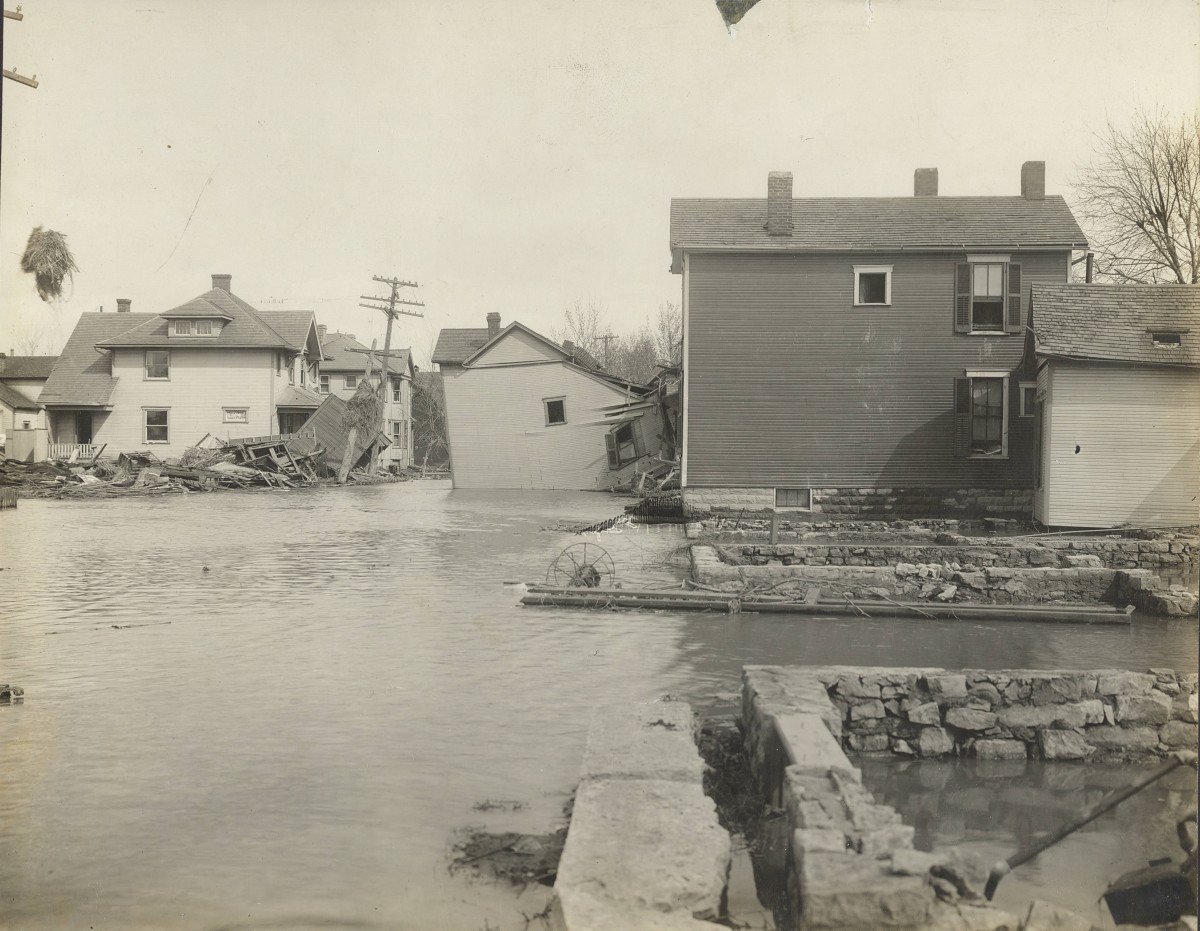A Vision of the Flood
A surviving photograph from the aftermath of the Great Dayton Flood of 1913. Perhaps the photograph mentioned in the article, although there is no notation as to location.
In 1914 the Dayton Daily News ran a ghost story contest that attracted paranormal stories of all types. The Great Dayton Flood of 1913 had occurred from 21-26 March, just the year before, killing 360 people, thousands of horses and animals, and destroying about 20,000 homes. I don’t know if the promoters of the contest were anticipating a cataract of tales of flood premonition or of drowned ghosts, but the usual patterns of catastrophic prophecy were not borne out: this is the only story I’ve in the collection seen relating to the Flood.
A VISION
On an afternoon nearly in the fall of 1912 Mrs. A. and Mrs. B. were returning from an afternoon’s shopping. Mrs. A. lives directly opposite Mrs. B. in East McPherson street.
We turned off Main street into McPherson street and had gone down this street about a hundred feet, from which point both our houses could be plainly seen. I was greatly surprised to see a house which seemed to have been moved into the street, blocking Linwood.
“What is the trouble down near our house?” I asked Mrs. B.
“Why, it looks as if they are moving a house,” she answered.
We both expressed wonder as to where it had been moved from, and where it was being taken.
All this time we were coming nearer to it. You can imagine our surprise when, in the winking of an eye, the house was gone. It had faded from our sight and we could see past Linwood street to the levee.
Mrs. Be. Looked at me with a foolish grin and remarked: “We must be seeing things.”
After a few seconds the seriousness of seeing such an unheard of thing in the clear daylight, and both to see the same thing at one time, dawned on us.
“Tell me just what you saw? Mrs. B.” I said.
She answered: “It looked as if during our absence a house of some kind had been moved into the middle of the street so that I could not see past Linwood. Now tell me what you saw?”
“I saw a house without foundation blocking our street at Linwood,” I answered.
Many suggestions came to me during the next few months. Had I been alone when this vision presented itself, I should have thought it imagination. Mrs. B. and I often spoke of the house, and what it could possibly mean. I even made inquiries of old residents of Riverdale, if ever a house had stood in that spot. But no one remembered it.
That some mystery was connected with our seeing it became a fixed thing in my mind. I mentioned the matter at a gathering in January, 1913, and was heartily laughed at.
Since the 25th of March, 1913, the vision has been explained.
I was informed by telephone by one of the ladies whom I had told our vision that a house blocked our street just as we had explained it to her in January.
And a picture of this house can be bought wherever flood pictures are sold.
Dayton [OH] Daily News 16 January 1914: p. 15
Naturally, this would have had more impact if Mrs. A. had immediately written her experience and sent it, along with Mrs. B.’s narrative, to the Society for Psychical Research. They would have followed up by asking for testimonies from the persons whom she asked about former houses and the group at the gathering who laughed at her vision. It’s possible that I might be able to identify the ladies with some further research in the Dayton City Directory. But, as it stands, it’s still a brilliant paranormal tale, rendered perhaps more plausible by its non-sensational telling.
East McPherson is a short street. You can see it on this map [labeled as “White Allen Ave,” along with Main St, Linwood, and the Great Miami River. Like much of Dayton’s downtown and older residential areas, the street lies on the Great Miami flood plain. Mrs. A. and Mrs. B. lived in the block between Main and Linwood. The street is no longer residential; there are a few businesses and many empty lots so I was unable to compare the photo above with any remaining buildings. The only reason for suggesting it might be the photo mentioned is that surprisingly few flood photos from Dayton (I’ve only seen one) show a house in the middle of a street.
![A map showing East McPherson [it becomes West McPherson at Main], Linwood, and the Great Miami River.](http://www.hauntedohiobooks.com/wp-content/uploads/dayton-flood-story-map2.jpg)
A map showing East McPherson [now White-Allen; it becomes West McPherson at Main], Linwood, and the Great Miami River.
Other stories from the Great Dayton Flood of 1913? chriswoodyard8 AT gmail.com
This story will be appearing in an as-yet-unnamed sequel to The Ghost Wore Black: Ghastly Tales from the Past.
Thanks to Curt Dalton, author of Through Flood, Through Fire: Personal Stories of Survivors of the Dayton Flood of 1913, Curt Dalton’s Gem City Gems, as well as several dozen more superb books on the many facets of Dayton’s history. He runs Dayton History Books Online.
Chris Woodyard is the author of The Victorian Book of the Dead, The Ghost Wore Black, The Headless Horror, The Face in the Window, and the 7-volume Haunted Ohio series. She is also the chronicler of the adventures of that amiable murderess Mrs Daffodil in A Spot of Bother: Four Macabre Tales. The books are available in paperback and for Kindle. Indexes and fact sheets for all of these books may be found by searching hauntedohiobooks.com. Join her on FB at Haunted Ohio by Chris Woodyard or The Victorian Book of the Dead.

